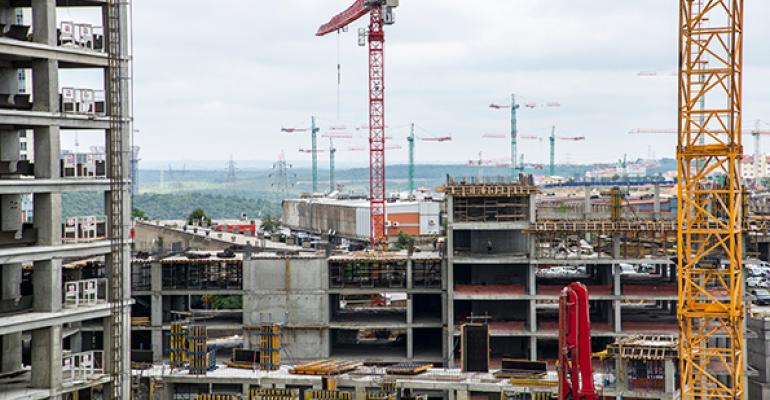In today’s market, developers can’t build new industrial properties fast enough to meet the demand from tenants and investors. In the first half of 2015, strong demand for industrial space pushed U.S. occupancy and absorption rates to record highs.
Slightly more than 50 million sq. ft. of new industrial space came on-line in the second quarter, according to a recent from real estate services firm Colliers International, but more than 72 million sq. ft. was absorbed, the highest level of demand seen post-recession. Dwight Hotchkiss, national director of the U.S. industrial group with Colliers, said in a statement that with national vacancy now at 6.4 percent and demand riding high, the industrial sector continues to post the highest average cap rates of any of the commercial property types.
There are about 156 million sq. ft. of new development under construction, consisting mostly of large distribution centers, according to the Colliers report. Also, a growing portion of the new supply (about 56 percent) is speculative development, reflecting sustained optimism in the industry and an anticipation of ongoing growth, Hotchkiss said.
Mike Brennan, chairman and managing principal of Chicago-based Brennan Investment Group, says most industrial firms are jumping back into construction, after the supply shut-off experienced during the recent recession. Firms concentrated on acquisitions from 2009-2012, but since 2013, leasing improved so much that deals are now hard to come by, he notes.
“I would say that the firms that had been largely development-orientated are now pretty busy,” Brennan says. “Four years ago, you would have a cold reception if you wanted someone to finance a speculative development. Today, there’s a multitude of finance options available. We’ve reabsorbed all of the space shed during the recession. Today, if you want a class-A product, you can’t find it to buy; you have to build it yourself.”
Brennan attributes the demand increase to e-commerce, as well as the resurgence of the U.S. manufacturing industry. Global instability and improvements in technology have pushed even more manufacturing businesses into the U.S., he says.
“I think you have to look at the rise of robotics, everyone in assembly has automated facilities. Industries that [U.S.] lost because of high wages are coming back because of a greater use of robotics,” Brennan says. “The other thing that’s happened is that China has become more expensive. The manufacturers there now have a middle-class domestic constituency to sell to, and are more reluctant to make U.S. price concessions. I think we’re entering another golden age of U.S. industrial development, as the sucking sound has switched from China to North America.”
There are definitely signs of a boom in U.S. development, says Mike Bell, vice president of industrial development with Hunt Midwest, a real estate development company. E-commerce and the growing manufacturing sector is spurring significant demand in the major distribution hubs such as Dallas and Los Angeles. The Kansas City region, where Hunt Midwest is based, is expecting almost 4 million sq. ft. of new development, matching Dallas’ growth even though Kansas City is a third of the size, Bell says. His firm just added another 2 million sq. ft. of available space to the Hunt Midwest Business Center, located near Kansas City’s FedEx Ground hub and the Norfolk Southern Intermodal facility.
“The faster you get buildings on-line, the more likely companies are going to choose your location,” he says. “On a speculative building we recently announced, we’re already talking with two companies to take half the building. It has gotten so that if you’re not already in the ground or [with] permit in hand, you may lose the deal. Companies are choosing to locate in entire markets based on availability of who’s going to be in the ground faster.”

